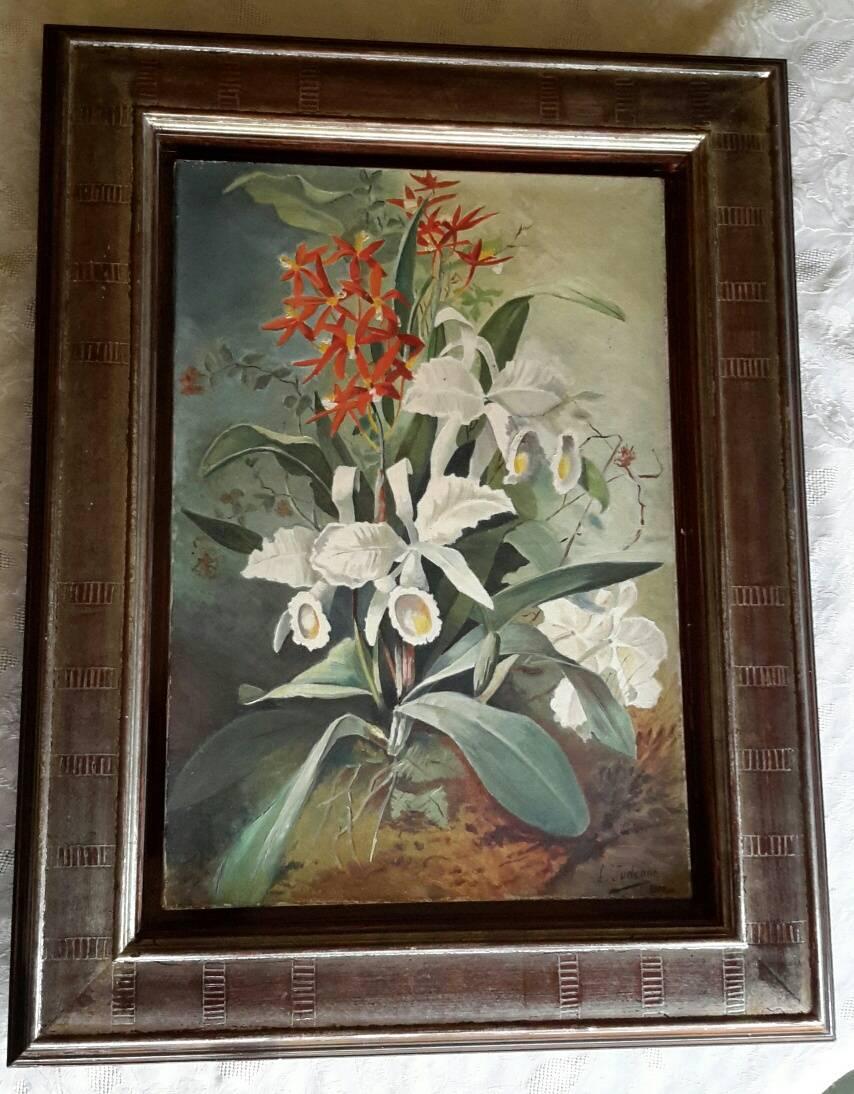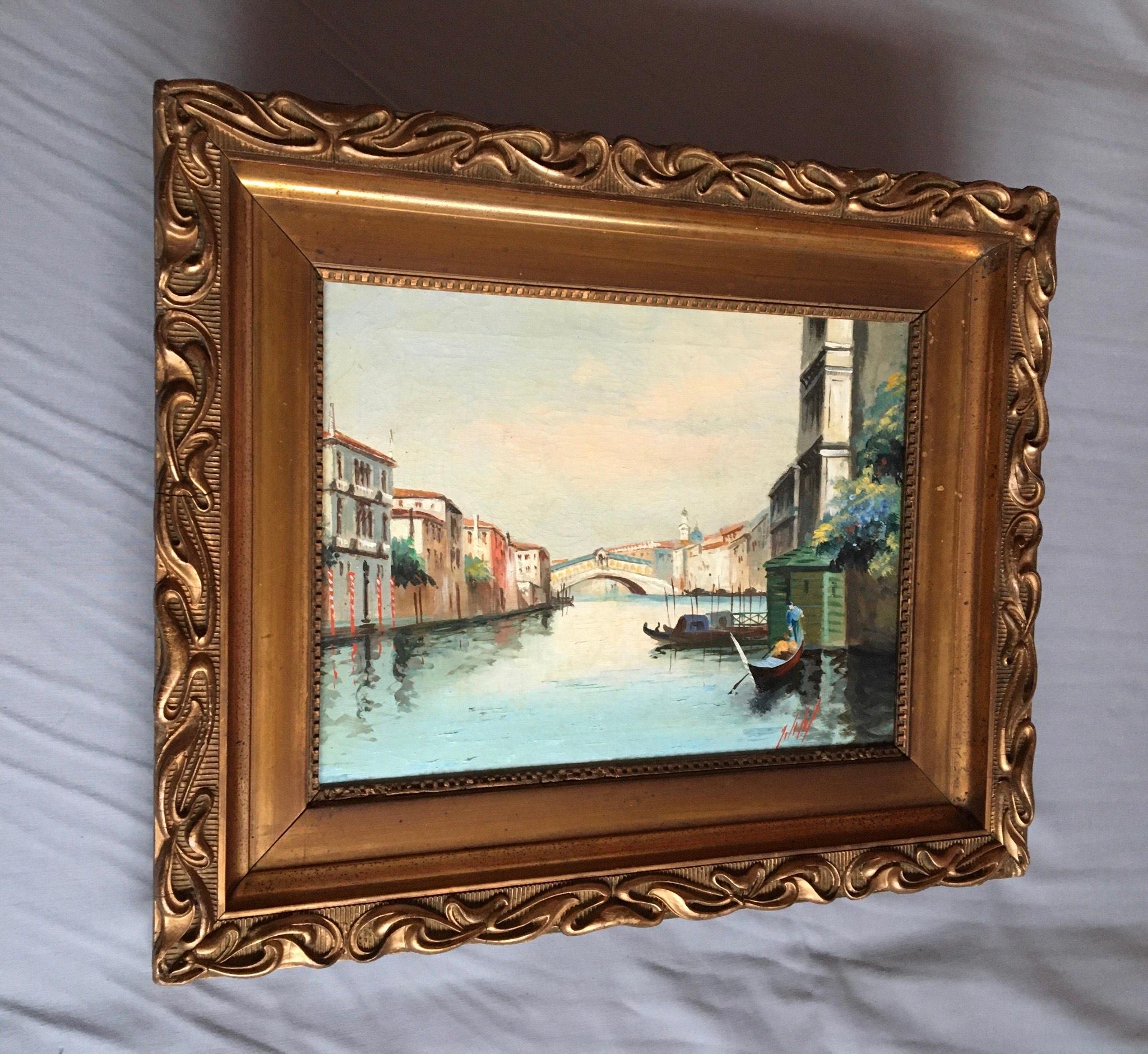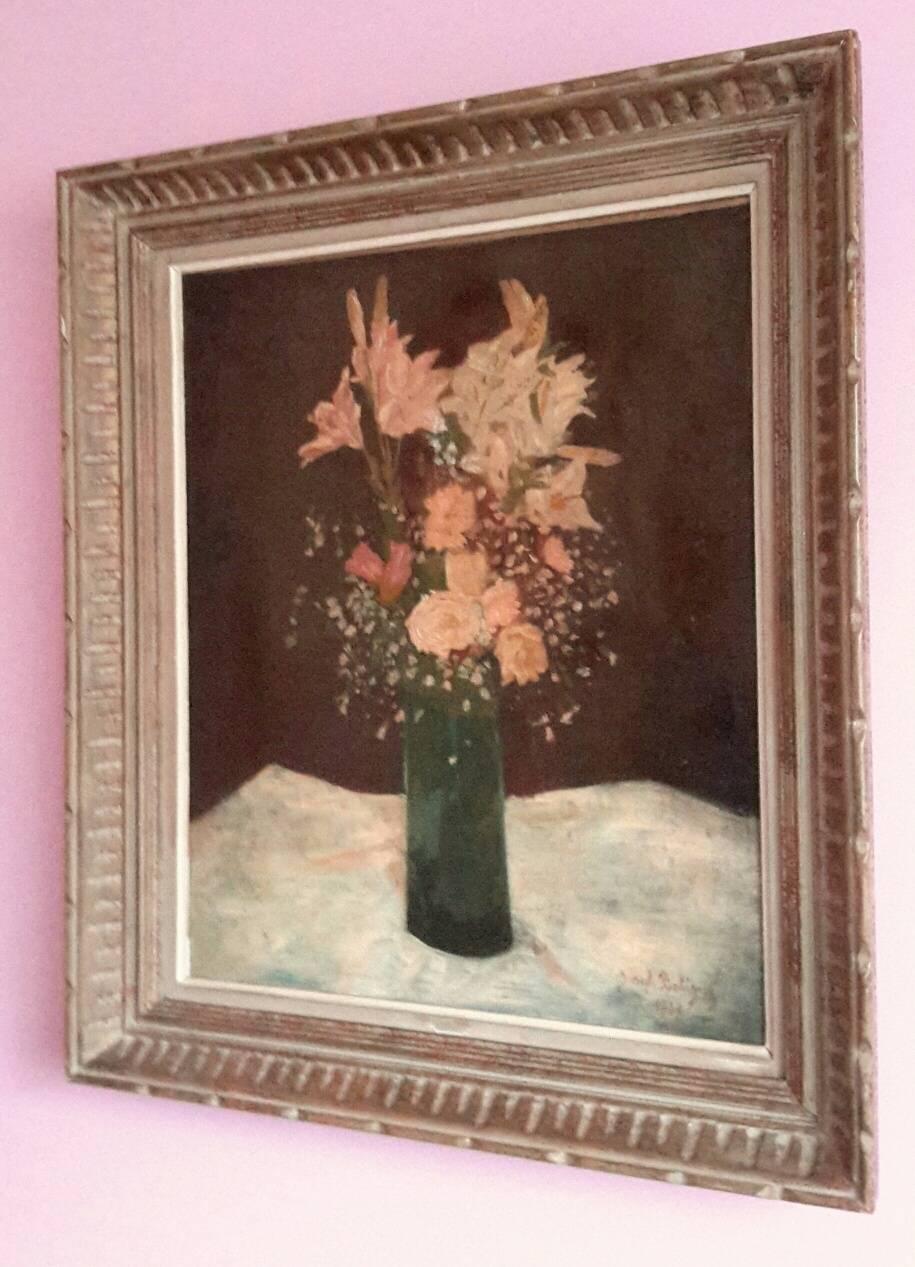Items Similar to Madonna del Dito - Heavenly beauty down to the fingertip -
Video Loading
Want more images or videos?
Request additional images or videos from the seller
1 of 7
UnknownMadonna del Dito - Heavenly beauty down to the fingertip -about 1880
about 1880
About the Item
KPM, Madonna del Dito, oval, slightly curved porcelain picture plate by KPM Berlin in fine polychrome onglaze painting, 27 x 22 cm (plate size), 33 x 28.5 cm (frame), unsigned, press mark from 1825, probably last third of the 19th century. Gold moulded wooden frame of the period.
- Minimal loss of paint to the margins, period frame somewhat rubbed and with a superficial hairline crack to the front.
About the artwork
The type of the Madonna del Dito (Madonna with the Finger) goes back to a painting by Carlo Dolci, now lost. Dolci painted it in the middle of the 17th century on copper, which gives the painting the character of fine enamel. This effect is enhanced by painting on porcelain. As if by soft-focus, Mary's lovely face appears almost transfigured, but at the same time it shows a precision that emphasises the delicacy of her features with sharp contours. Only porcelain painting can achieve the effect of melting softness with such precision, and here it has been achieved to perfection.
In an oval field, Mary appears dressed in a cobalt blue mantle against a dark brown background. The robe forms a kind of niche from which her face shines out. Her eyelids are half closed, suggesting that she is lost in thought. According to Luke, "But Mary kept all these words in her heart, and gave much thought to them" (Lk 2:19), meditating on the divine grace that had been bestowed on her, giving her beauty an unfathomable depth. As the chosen Mother of God, Mary's perfect beauty is at the same time a purity untainted by the Fall. She is the temple of God, which is itself holy, as the delicate halo around her head makes clear. The brown tone of the background, lightened to ochre, is echoed in the brown undergarment, under which Mary's finely drawn golden hair is visible.
The dominant blue, which adds to the depth, is also symbolic: it represents heaven and identifies Mary as the Queen of Heaven, crowned by the aura of a halo.
Her hands, clasped as if in prayer, are wrapped in the celestial robe, only the finger that gives the name to the picture peeps out from under the mantle, giving the Mother of God something human but also something divine, since she touches the celestial blue with her finger and influences it with her touch. An effective power that makes Mary a great intercessor.
Last but not least, the fingertip with the convincingly depicted fingernail is also an expression of the precision of the fine painting before the eye.
While painting on copper plates, which is comparable in its aesthetic effect, was widespread especially in the 17th and early 18th centuries, painting on porcelain had its heyday in the second half of the 19th century and was brought to perfection in the Königliche Porzellan-Manufaktur Berlin (KPM).
Thank you for your interest! I hope I have been able to explain to you the special character of the artwork. If you have any questions of any kind, please feel free to contact me.
I wish you many more discoveries in the realm of art,
Dr Martin Kirves
GERMAN VERSION
KPM, Madonna del Dito, ovale leicht gewölbte Porzellan-Bildplatte der KPM Berlin in feiner polychromer Aufglasurmalerei, 27 x 22 cm (Plattenmaß), 33 x 28,5 cm (Rahmen), unsigniert, Pressmarke ab 1825, wohl letztes Drittel des 19. Jh. Goldprofilierter Holzrahmen der Zeit.
- am Randbereich minimale Farbfehlstellen, Rahmen der Zeit etwas berieben und mit oberflächlichem Haarriss an der Vorderseite
zum Kunstwerk
Der Typ der Madonna del Dito (Madonna mit dem Finger) geht auf ein heute verschollenes Gemälde von Carlo Dolci zurück. Dolci hatte es in der Mitte des 17. Jahrhunderts auf Kupfer gemalt, wodurch die Malerei den Charakter eines feinen Schmelzes bekommt. Diese Wirkung wird durch die Malerei auf Porzellan noch gesteigert. Wie durch einen Weichzeichnereffekt scheint das liebliche Antlitz Marias geradezu verklärt zu sein, weist dabei aber zugleich eine Präzision auf, die die Grazilität ihrer Züge konturenscharf zur Darstellung bringt. Der Effekt einer schmelzartigen Weiche bei gleichzeitiger höchster Präzision ist in dieser Intensität einzig in der Porzellanmalerei zu erreichen und steht hier in höchster Perfektion vor Augen.
Innerhalb eines ovalen Bildfeldes erscheint Maria, in einen kobaltblauen Mantel gekleidet, vor einem dunkelbraunen Hintergrund. Das Gewand bildet eine Art Nische, aus der ihr Antlitz herausleuchtet. Die halbgesenkten Augenlieder verdeutlichen, dass sie sinnierend in sich versunken ist. Gemäß dem Lukaswort, „Maria aber bewahrte alle diese Worte und erwog sie in ihrem Herzen“ (Lk 2,19), meditiert sie über die ihr zuteil gewordene göttliche Gnade, was ihrer Schönheit eine unergründliche Tiefe verleiht. Als auserwählte Mutter Gottes ist Marias vollendete Schönheit zugleich eine durch den Sündenfall unbefleckte Reinheit. Sie ist der Tempel Gottes, der selbst heilig ist, was durch das zarte heiligenscheinartige Aufleuchten um ihren Kopf sichtbar wird. Die ins ockerfarbene aufgehellte Brauntonalität des Hintergrundes findet sich im braunen Untergewand wieder, unter dem Marias fein gezeichnetes goldenes Haar sichtbar wird.
Das zur Tiefgründigkeit beitragende dominierende Blau ist ebenfalls auch symbolischer Natur: Es steht für den Himmel ein und weist Maria als Himmelskönigin aus, die von der Aura eines Heiligenscheins gekrönt wird.
Ihre wie zum Gebet gehaltenen Hände sind vom himmlischen Gewand umhüllt, einzig der namensgebende Finger schaut unter dem Mantel hervor, was der Muttergottes etwas Menschliches verleiht, zugleich aber auch etwas Göttliches hat, da sie mit dem Finger das himmlische Blau berührt und es durch ihre Berührung beeinflusst. Eine Wirkmacht, die Maria zur großen Fürbitterin werden lässt.
Nicht zuletzt ist die Fingerkuppe mit dem überzeugend dargestellten Fingernagel aber auch Ausdruck der Akkuratesse der vor Augen stehenden Feinmalerei.
Während das in seiner ästhetischen Wirkung vergleichbare Malen auf Kupfertafeln vor allem im 17. und frühen 18. Jahrhundert verbreitet war, hat die Malerei auf Porzellan in der zweiten Hälfte des 19. Jahrhunderts ihre Blütezeit und wurde in der Königlichen Porzellan-Manufaktur Berlin (KPM) zur höchsten Vollendung gebracht.
Vielen Dank für Ihr Interesse! Ich hoffe, ich habe Ihnen den besonderen Charakter des Kunstwerks näherbringen können. Bei Fragen jeglicher Art können Sie mich gerne kontaktieren.
Ich wünsche Ihnen noch viele Entdeckungen im Reich der Kunst,
Dr. Martin Kirves
- Creation Year:about 1880
- Dimensions:Height: 27 in (68.58 cm)Width: 22 in (55.88 cm)
- Medium:
- Movement & Style:
- Period:
- Condition:Minimal loss of paint to the margins, period frame somewhat rubbed and with a superficial hairline crack to the front.
- Gallery Location:Berlin, DE
- Reference Number:1stDibs: LU2438211896442

About the Seller
5.0
Vetted Seller
These experienced sellers undergo a comprehensive evaluation by our team of in-house experts.
Established in 2014
1stDibs seller since 2023
7 sales on 1stDibs
Typical response time: 7 hours
- ShippingRetrieving quote...Ships From: Berlin, Germany
- Return PolicyA return for this item may be initiated within 14 days of delivery.
More From This SellerView All
- The gift of flowersBy Conrad KieselLocated in Berlin, DEConrad Kiesel (1846-1921), The gift of flowers. Oil on wood, 43 x 35 cm, 69 x 61 cm (frame), signed at lower left "Conrad Kiesel pxt [pinxit]", about 1900. In a magnificent gilt stuc...Category
1890s Academic Nude Paintings
MaterialsOil
- Feeding the Kittens - Little cat mother -Located in Berlin, DEErnst Albert Fischer-Cörlin (1853 Körlin - 1932 Persante). Feeding the Kittens, 1893. Pencil on painting cardboard, 38 x 29 cm. Signed and dated by the artist at lower left "E[rnst] A[lbert] Fischer=Cörlin 1893". - Lightly stained, somewhat dusty and minimally foxed. - Little cat mother - About the artwork Daughter, mother and grandmother gather in the sunlight to feed a litter of kittens. The mother and grandmother hold the lively, playful animals in their arms, while the young girl feeds two of the four kittens with cookies. There is also a small bucket of milk and a bowl of milk. The women and the girl watch as the cute, still blind animals eat. It is a scene taken from everyday life, but it also has an allegorical dimension, bringing maternal care into the representation. Three generations are represented, with the grandmother and the mother already mothers. They not only offer the kittens to the youngest, but also proudly observe the maternal care that the youngest gives to the kittens. Like the kittens, she will grow up and become a mother herself, so the image is also an allegory of life's ever-new beginnings. In keeping with this, the morning sun shines into the picture from the right. Fischer-Cörlin has masterfully worked out the quality of the light, with its light and dark areas, with the pencil used...Category
1890s Academic Animal Drawings and Watercolors
MaterialsCardboard, Carbon Pencil
- Mary Magdalene - Faith transforms inner into outer beauty and conquers death -By Balthasar DennerLocated in Berlin, DEBalthasar Denner (1685 Hamburg - 1749 Rostock). Mary Magdalene. Oil on copper, 37 × 32 cm (visible size), 45 x 40 cm (frame), signed and indistinctly dated "Denner 17(...)" at centre...Category
1720s Old Masters Figurative Paintings
MaterialsCopper
- Still life with meadow flowers - The beauty of meadow flowers -Located in Berlin, DEJean-Baptiste Robie (1821 Brussels - 1910 ibid.). Still life with meadow flowers. Oil on wood, 24.5 x 18.5 cm (inside measurement), 37 x 31 cm (frame), signed and dated (difficult to...Category
Early 1900s Naturalistic Still-life Paintings
MaterialsCanvas, Oil
- Sunny woodland path - A brightly lit forest path as a space for imagination -Located in Berlin, DEWilhelm Schütze (1840 Kaufbeuren - 1898 Munich). Forest path. Oil on painting board, 30 x 24 cm (visible size), 31 x 26 cm (frame), signed lower left "Wilhelm Schütze". About the a...Category
1880s Naturalistic Landscape Paintings
MaterialsOil, Cardboard
- Landscape with Trees by a Lake - Eternal summer silence over an abysmal lake -Located in Berlin, DEAndreas Thomas Juuel (1816 Copenhagen - 1868 Copenhagen). Summer landscape with tall deciduous trees by a lake. Oil on canvas, 54,5 x 42 cm (visible size), 71 x 58 cm (frame), signed...Category
1850s Realist Landscape Paintings
MaterialsOil
You May Also Like
- "Strawberries in a Basket"By J. MarsacLocated in Southampton, NYCirca 1890 Signed lower right Lewis Straus and Sons importers Stamped Limoges, FranceCategory
1910s Academic More Art
MaterialsPorcelain
- 19th Cent French Still Life by L. JudenneLocated in Paris, FRBeautiful 19th Century French School oil on canvas signed on the right by L. Judenne and dated 1900. The painting represents a floral composition .in a very good general condition, ...Category
1890s Academic Still-life Paintings
MaterialsCotton Canvas, Oil
- Still Life with Vase and LemonsLocated in Mokena, ILStill Life with Vase and Lemons, 17.75 x 21.75 inches. Oil on Canvas. Painting by artist Justas Varpucanskis. 21st century contemporary artwork done in an academic-impressionistic ma...Category
21st Century and Contemporary Academic Still-life Paintings
MaterialsOil
- Rialto Bridge, Venice by Dellal, 1950Located in Paris, FRBeautiful oil on canvas of the 50’s figuring a peaceful view of the Rialto on the Grand Canal in Venezia. The oil is in good condition with some old réfections visible in the back. The painting is signed on the bottom right Delall and countersigned on the back. It comes with a charming old gilted and ornamented in Barocco style...Category
20th Century Academic Landscape Paintings
MaterialsOil, Canvas
- Nature Morte Vase des FleursBy Joseph BobignyLocated in Paris, FRVery beautiful French school painting of the early 20th century representing a floral arrangement of roses and lilies in a vase. A beautiful work réalised with delicacy and a choice...Category
1910s Academic Still-life Paintings
MaterialsCanvas, Oil
- "Portrait of the Black Ball Clipper Montezuma"By William Minshall BirchallLocated in Southampton, NYWatercolor on paper by William Minshall Birchall of the black ball clipper ship, the Montezuma. Titled and signed W. M. Birchall lower left in pencil. Findlay Gallery label verso. 0riginal frame and mat with normal wear due to age. The American packet ship...Category
Early 1900s Academic More Art
MaterialsPaper, Watercolor





